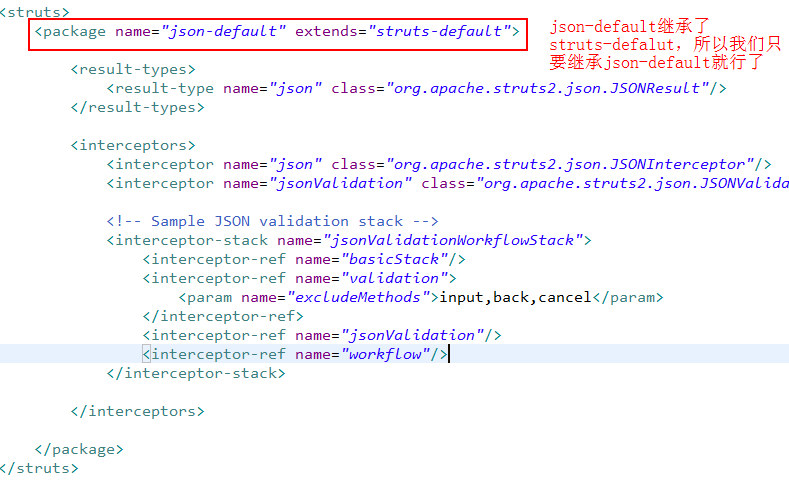SSH框架网上商城项目第7战之整合Struts2和Json
上篇我们完成了DataGrid显示json数据,但是没有和后台联系在一起,只是单纯地显示了我们自己弄的json数据,这一节我们将json和Struts2整合,打通EasyUI和Struts2之间的交互。
1. json环境的搭建
json环境搭建很简单,导入json的jar包即可,如下:

(注:json-lib-2.4的jar包下载地址:http://xiazai.jb51.net/201605/yuanma/json-lib-2.4(jb51.net).rar )
2. 完善Action
在DataGrid控件中有个属性是url,可以指定请求数据的url地址,在上一节我们将这个地址直接设置成了一个具体的json文件,这里我们将这个url设置成一个action,如url:'category_queryJoinAccount.action',表示会去请求categoryAction的queryJoinAccount方法(文章最后会给出query.jsp的代码)。所以我们需要去完成categoryAction中的queryJoinAccount方法。
在Struts2和json整合前,我们先看一下之前显示一次json数据都发了哪些请求:

因为type是Category类的一个属性,我们在BaseAction中已经实现了ModelDriven<Category>接口,所以这个type会被封装到model中,我们不需要管它,可以通过model来获取,但是EasyUI自动发过来的page和rows参数我们需要自己获取了,所以我们可以在BaseModel中增加两个成员变量page和rows并实现get和set方法,最后还要考虑一点,这些参数都获得了后,我们根据这些参数去数据库中查询数据,那么我们查出来的数据放到哪呢?而且还要打包成json格式发到前台才能被DataGrid显示。我们先不考虑将查询到的数据如何打包成json格式,我们先考虑把这些数据放到一个地方,很自然的想到了使用Map,因为json格式的数据就是key-value形式的。想到这里,我们继续完善BaseAction:
@Controller("baseAction")
@Scope("prototype")
public class BaseAction<T> extends ActionSupport implements RequestAware,SessionAware,ApplicationAware,ModelDriven<T> {
//page和rows和分页有关,pageMap存放查询的数据,然后打包成json格式用的
//page和rows实现get和set方法,pageMap只需要实现get方法即可,因为pageMap不是接收前台参数的,是让struts获取的
protected Integer page;
protected Integer rows;
protected Map<String, Object> pageMap = null;//让不同的Action自己去实现
//省略get和set方法……
/******************* 下面还是原来BaseAction部分 *************************/
//service对象
@Resource
protected CategoryService categoryService;
@Resource
protected AccountService accountService;
//域对象
protected Map<String, Object> request;
protected Map<String, Object> session;
protected Map<String, Object> application;
@Override
public void setApplication(Map<String, Object> application) {
this.application = application;
}
@Override
public void setSession(Map<String, Object> session) {
this.session = session;
}
@Override
public void setRequest(Map<String, Object> request) {
this.request = request;
}
//ModelDriven
protected T model;
@Override
public T getModel() {
ParameterizedType type = (ParameterizedType)this.getClass().getGenericSuperclass();
Class clazz = (Class)type.getActualTypeArguments()[0];
try {
model = (T)clazz.newInstance();
} catch (Exception e) {
throw new RuntimeException(e);
}
return model;
}
}
好,完善了BaseCategory后,我们可以写categoryAction中的queryJoinAccount方法了,我们将categoryAction中原来的方法全删掉,因为那些都是之前搭建环境时候测试用的,都不用了,现在真正开始项目代码了:
@Controller("categoryAction")
@Scope("prototype")
public class CategoryAction extends BaseAction<Category> {
public String queryJoinAccount() {
//用来存储分页的数据
pageMap = new HashMap<String, Object>();
//根据关键字和分页的参数查询相应的数据。这个方法我们在Service中写过了,当时完成级联查询
List<Category> categoryList = categoryService.queryJoinAccount(model.getType(), page, rows);
pageMap.put("rows", categoryList); //存储为JSON格式,从上一节的json文件可以看出,一个key是total,一个key是rows,这里先把rows存放好
//根据关键字查询总记录数
Long total = categoryService.getCount(model.getType()); //这个方法没写,我们等会儿去Service层完善一下
// System.out.println(total);
pageMap.put("total", total); //存储为JSON格式,再把total存放好
return "jsonMap";
}
}
这样Action我们就写好了,现在Action拿到前台传来的参数,然后根据参数查询了指定type的总记录数,以及指定type的所有商品,并且按照json中指定的key(即total和rows)进行存放,放在HashMap中了,之后只要将这个HashMap中的数据打包成json格式发送到前台就可以被DataGrid显示了。我们先把这个HashMap放这,先去完善了Service层的代码后,再来打包这个HashMap中的数据。
3. 完善categoryService
从上面的categoryAction中可知,需要在categoryService中增加一个getCount方法,并且要在具体实现类中实现好,实现如下:
//CategoryService接口
public interface CategoryService extends BaseService<Category> {
//查询类别信息,级联管理员
public List<Category> queryJoinAccount(String type, int page, int size); //使用类别的名称查询
//根据关键字查询总记录数
public Long getCount(String type);
}
//CategoryServiceImpl实现类
@SuppressWarnings("unchecked")
@Service("categoryService")
public class CategoryServiceImpl extends BaseServiceImpl<Category> implements CategoryService {
@Override
public List<Category> queryJoinAccount(String type, int page, int size) {
String hql = "from Category c left join fetch c.account where c.type like :type";
return getSession().createQuery(hql)
.setString("type", "%" + type + "%")
.setFirstResult((page-1) * size) //从第几个开始显示
.setMaxResults(size) //显示几个
.list();
}
@Override
public Long getCount(String type) {
String hql = "select count(c) from Category c where c.type like :type";
return (Long) getSession().createQuery(hql)
.setString("type", "%" + type + "%")
.uniqueResult(); //返回一条记录:总记录数
}
}
到现在为止,这个数据库中数据的获取这条路就打通了,前面两步完成了从前台-->数据库-->取数据,接下来就开始打包HashMap中存放的数据,然后发给前台了。
4. 配置struts.xml
在struts.xml中通过配置就可以完成对指定数据的打包,我们先看一下struts.xml中的配置:
<struts>
<constant name="struts.devMode" value="true" />
<package name="shop" extends="json-default"><!-- jason-default继承了struts-default -->
<global-results>
<result name="aindex">/WEB-INF/main/aindex.jsp</result>
</global-results>
<!-- class对应的是Spring中配置该Action的id值,因为要交给Spring管理 -->
<action name="category_*" class="categoryAction" method="{1}">
<!-- 必须要先添加json包,然后上面继承json-default -->
<result name="jsonMap" type="json">
<!-- 要转换成json对象的数据 -->
<param name="root">pageMap</param>
<!-- 配置黑名单,过滤不需要的选项 ,支持正则表达式
json格式:{total:3,rows:[{account:{id:2,login:"user",name:"客服A",pass:"user"},hot:true,id:3,…}]}
-->
<param name="excludeProperties">
<!-- rows[0].account.pass-->
<!-- 这里显示不了正则表达式, CSDN的一个bug,我接个图放下面 -->
</param>
</result>
</action>
<action name="account_*" class="accountAction" method="{1}">
<result name="index">/index.jsp</result>
</action>
<!-- 用来完成系统 请求转发的action,所有的请求都交给execute-->
<action name="send_*_*" class="sendAction">
<result name="send">/WEB-INF/{1}/{2}.jsp</result>
</action>
</package>
</struts>

从上面的配置可以看出,首先package要继承json-default,因为json-default继承了struts-default,因为在json的jar包里有个struts2-json-plugin-2.3.24.1.jar,打开即可看到里面有个struts-plugin.xml,打开即可看到json-default是继承了struts-default:

接下来我配置<result>,name是刚刚action返回的字符串,type一定要配成json。然后就是result中的参数了,首先必须要配的就是name为root的参数,这个参数要配成刚刚需要转换的HashMap对象,即我们定义的pageMap,有了这个参数的配置,struts才会将pageMap中的数据打包成json格式。然后就是配置黑名单,黑名单的意思就是告诉struts在打包的时候,哪些字段不需要打包,比如管理员密码之类的信息,由上面注释中的jason格式可以看出rows[0].account.pass表示密码字段,但是数据肯定不止一条,所以我们得用正则表达式来表示,这样所有密码都不会被打包到json中。
5. 修改query.jsp内容
到此,我们已经将数据打包成了json格式了,接下来我们完善一下前台query.jsp的内容就可以让DataGrid正确显示了:
<%@ page language="java" import="java.util.*" pageEncoding="UTF-8"%>
<!DOCTYPE HTML PUBLIC "-//W3C//DTD HTML 4.01 Transitional//EN">
<html>
<head>
<%@ include file="/public/head.jspf" %>
<script type="text/javascript">
$(function(){
$('#dg').datagrid({
//url地址改为请求categoryAction
url:'category_queryJoinAccount.action',
loadMsg:'Loading......',
queryParams:{type:''},//type参数,这里不需要传具体的type,因为我们要显示所有的
//width:300,
fitColumns:true,
striped:true,
nowrap:true,
singleSelect:true,
pagination:true,
rowStyler: function(index,row){
console.info("index" + index + "," + row)
if(index % 2 == 0) {
return 'background-color:#fff;';
} else {
return 'background-color:#ff0;';
}
},
frozenColumns:[[
{field:'checkbox',checkbox:true},
{field:'id',title:'编号',width:200} //这里的field字段要和数据库中的一样,也就是要跟json数据中的一样
]],
columns:[[
{field:'type',title:'类别名称',width:100, //字段type
formatter: function(value,row,index){
return "<span title=" + value + ">" + value + "</span>";
}
},
{field:'hot',title:'热卖',width:100, //字段hot
formatter: function(value,row,index){
if(value) { //如果是hot,该值为true,value是boolean型变量
return "<input type='checkbox' checked='checked' disabled='true'"; //勾选
} else {
return "<input type='checkbox' disable='true'"; //不勾选
}
}
},
{field:'account.login',title:'所属管理员',width:200, //account.login管理员登录名
formatter: function(value,row,index){
if(row.account != null && row.account.login != null) {
return row.account.login; //如果登录名不为空,显示登录名
} else {
return "此类别没有管理员";
}
}
}
]]
});
});
</script>
</head>
<body>
<table id="dg"></table>
</body>
</html>
6. 测试显示结果
最后我们测试一下DataGrid的显示结果,如下:

到这里,我们成功整合了Struts2和json,现在可以和前台传输json格式的数据了。
(注:到最后我会提供整个项目的源码下载!欢迎大家收藏或分享)
原文地址:https://www.geek-share.com/detail/2673755781.html
以上就是本文的全部内容,希望对大家的学习有所帮助,也希望大家多多支持脚本之家。
您可能感兴趣的文章:
- Linux Generating SSH Keys
- 使用 Python 处理 JSON 格式的数据
- XML 与 JSON 优劣对比
- VBA将excel数据表生成JSON文件
- newtonsoft.json解析天气数据出错解决方法
- 插件管理框架 for Delphi(一)
- vbs 解析json jsonp的方法
- Ruby和Ruby on Rails中解析JSON格式数据的实例教程
- 使用CSS框架布局的缺点和优点小结
- Extjs4如何处理后台json数据中日期和时间
- C#实现将类的内容写成JSON格式字符串的方法
- JQuery ajax返回JSON时的处理方式 (三种方式)
- jquery JSON的解析方式示例介绍
- c#版json数据解析示例分享
- ASP JSON类文件的使用方法
- 一起动手编写Android图片加载框架
- 基于.NET平台常用的框架和开源程序整理
- C# JSON格式化转换辅助类 ConvertJson
- C#实现对Json字符串处理实例
